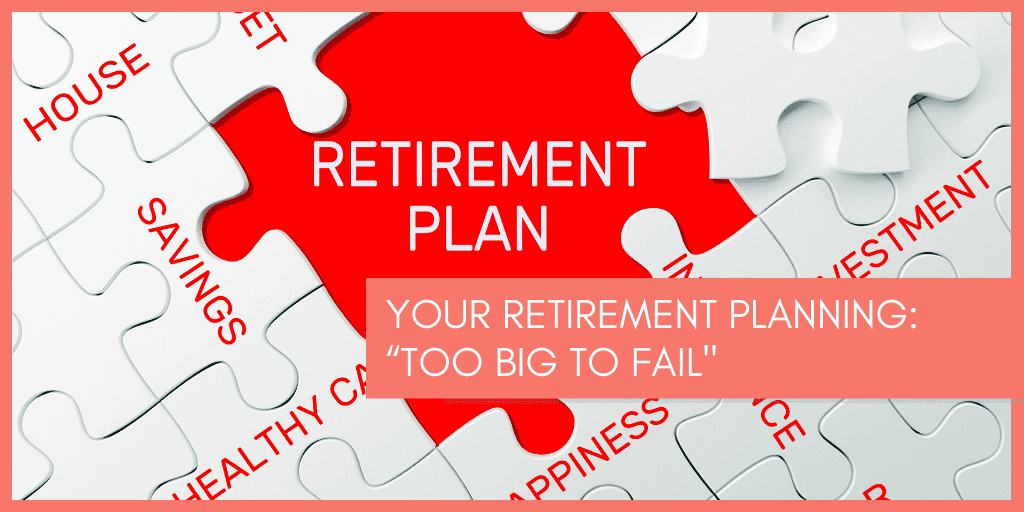


Plan Your Finances as You Would Your Exercise
March 8, 2021


Traditional IRAs versus Roth IRAs
March 30, 2021Many of us remember the phrase “too big to fail” from the 2008 financial crisis and cringe now that its use has been resurrected during the coronavirus pandemic. Others remember that the term was also used in 1984 by U.S. Congressman Stewart McKinney when he talked about the FDIC’s intervention with Continental Illinois, which became the largest bank failure in history until the failure of Washington Mutual in 2008. The concept of “too big to fail” is simple: some companies (or industries) are so important to the day-to-day functioning of our lives that they just can’t be allowed to collapse.
During the 2008 financial crisis, it was the banks and financial firms that were deemed “too big to fail.” Today, it’s the Airline Industry, notably Boeing, Delta, American, and United. But the term is also being applied to GM and the Auto Industry; Marriott and the Hotel Industry; plus Chevron and the Oil Industry.
Your Retirement is Too Big to Fail
But what about your retirement planning? Shouldn’t you consider your retirement as “too big to fail?”
Remember, underneath all of this “too big to fail” chatter is the American consumer, which accounts for more than 2/3 of U.S. GDP. And integral to our spending, of course, is how much we save and how we plan for retirement.
Sadly, there are a lot of misperceptions surrounding retirement planning, such as the importance of contributions and returns, the reliability of guarantees and what a safe withdrawal rate is.
As you think about your nest egg and the idea that it’s meant to last you through your old age, it’s vital to get a clear-eyed view of what is real and what isn’t.
Let’s examine five common retirement planning misperceptions and how to avoid.
#1: Mixing Up Investing with Planning
In reality, one sets the stage for the other. Planning comes first. Otherwise, what is the investment goal to begin with? In other words, what is the investment supposed to do for you – not your neighbor or water cooler conversationalist. If you simply chase investment performance, then you’ve missed the purpose of investing.
Many believe making money is the goal. How much is enough under that metric? What is the definition of success: reaching your goal, without moving the goal posts? And what are the risks with that perspective?
#2: Returns Versus Contributions
It’s a mistake to think that investment returns are more important, when you are still working, than your contributions. It is also true that when you retire, contributions remain more important, because you’re talking about reverse contributions, in other words retirement distributions.
Steady contributions over decades build wealth. In retirement, the right withdrawal rate, based on your age each year and for your situation, is the preeminent factor in your ability to maintain your financial well-being.
#3: Guaranteed Returns are Guaranteed
Many believe that guaranteed returns, such as from pensions and annuities, are rock-solid. That belief could prove disastrous. What guarantees do is shift the burden onto a third party, like a pension fund or an insurance company. Pensions and annuities rely on assumptions that may not hold true. This is why many pensions are underfunded today. In fact, Moody’s Investors Service estimates that public pensions are underfunded by $4.4 trillion.
Where does the extra money come from that is required to continue making those contractual payments? What happens when that extra money cannot be found? Some plans look to juice returns by leverage, meaning they borrow money. If the market goes wrong on them, the leverage deepens their losses. Both contributions and withdrawals suffer from what behavioral finance calls the money illusion.
When the global economy sinks, as it has recently, asset values everywhere go down in everything. But people mentally cling to their assets’ former values and overestimate their nest eggs. Their retirement account’s value is not sufficient to provide the post-work life they counted on. The reality is they need to reduce spending just a little until values may recover to support higher spending again.
#4: Risk Goes Away Over Time
Risk somehow goes away if you avoid down markets during the first few years of retirement, right? Wrong.
Popular methods of insulating against market risk include such strategies as buckets – where you divide your holdings into categories, such as risk assets like stocks, fixed income and cash. Those look great statically, but time is dynamic and you spend that money from one bucket without regard for sustainability for later.
How are depleted buckets later replenished when their values also go down? It is not very prudent to assume the values will recover over future. In addition, the perceptions of risk go out of kilter at times, creating bubbles and busts. Recent history reminds us of that.#5: Everyone Withdraws at the Same Rate
How crazy is this statement: of course a single safe retirement-withdrawal rate exists for everyone. Reality check: not all retirees are the same age.
Calculate a sustainable rate based on your present age, whether you want to consume all the assets or give some away to heirs, and how your portfolio balance is doing – is it going up or down?
Complicating the quest for a safe withdrawal rate: the older you get, the greater your odds are of increased longevity. For example, according to the Social Security Administration, the life expectancy of a 65-year-old male is 84 (19 more years) and a female’s is 86.5 (21.5 years). By the time they reach 80, the male life expectancy is 88.7 (8.7more years) and the female’s is 90 (10 years).
You can spend a dollar early in retirement, but at the cost of not having that dollar available to spend later in retirement. That spent dollar also has lost its ability to grow new dollars. Investment performance is one area you have no control over. Sticking money in a safe area, like a savings account, leaves its value at risk to inflation, over which you also have no control. Inflation robs value through depreciating currency. Purchasing power declines, yet people are fooled because the amount in savings stays the same.
A sustainable withdrawal considers the current portfolio value, not a value the portfolio used to have, or might have in the future. Both are wishful thinking.
Your Retirement is Much Too Big to Fail
The opinions voiced in this material are for general information only and are not intended to provide specific advice or recommendations for any individual. To determine which investment(s) may be appropriate for you, consult your financial professional prior to investing. All performance referenced is historical and is no guarantee of future results. All indices are unmanaged and cannot be invested into directly. All information is believed to be from reliable sources; however, LPL Financial makes no representation as to its completeness or accuracy. This article was prepared by AdviceIQ.
Content Provider: FMeX
LPL Tracking 01-05086051




